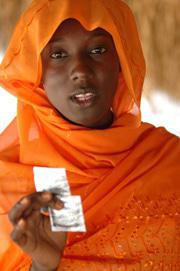North-Eastern province at higher HV risk

By 2008, 30 buses were running between the two cities, bringing better access to goods and services, and more interaction between the traditionally conservative people of North-Eastern Province and the rest of the country. New research has shown that these interactions may also be contributing to an increase in HIV infections in the region.
A study by the AIDS, Population and Health Integrated Assistance programme, funded by USAID, found that although the HIV prevalence of just over one percent in North-Eastern Province was still significantly lower than the estimated national average of around eight percent, the sexual risk behaviours of people in Garissa were similar to those of other Kenyans.
Researchers assessed HIV risk behaviours in key groups – including students, taxi drivers, milk traders and truck drivers – living in Garissa, and also in the Nairobi neighbourhood of Eastleigh, which is largely populated by people from the northeast.
They found that 22 percent of men and 35 percent of women in Garissa had engaged in transactional sex, while nine percent of men and 14 percent of women had been forced to have sex.
More than half the young people reported having multiple sexual partners and engaging in sex to acquire cell phones, clothing and jewellery; 41 percent of those with a regular sexual partner never used a condom.
“A friend can ask you to have a ‘puff’ [a brief sex session] with the lady he is pushing with,” one Garissa student told researchers. “Such puffs become frequent and the lady ends up having many sexual partners at the same time.”
The study also showed that many people from North-Eastern Province had low levels of knowledge about HIV, heightening their risk. Only one-third of the men and a quarter of the women named consistent condom use as a way to prevent HIV transmission, while just over half the women and 39 percent of the men identified faithfulness to one partner as a prevention strategy.
In Nairobi the main sources of information about HIV were television and other media, while in Garissa most people learned about it from religious leaders, parents and other family members.
Misconceptions about how HIV is transmitted were common, and almost 75 percent of respondents in both Garissa and Eastleigh believed that AIDS was a punishment from God. Stigma and discrimination against people living with HIV were higher in Garissa, but were also present in Eastleigh.
“The government always quarantines sick animals to protect those that are healthy; it should do the same to people with HIV/AIDS – we must be protected,” Ibrahim Dekow, a miraa (local herbal stimulant) trader in Garissa, told IRIN/PlusNews.
The authors recommended intensifying HIV education programmes at schools, and targeting high-risk groups like miraa and milk vendors, sex workers and out-of-school youth with prevention programmes.
They also suggested working with religious leaders and using familiar faces – such as local women wearing the customary Islamic headscarf, or hijab – to deliver HIV prevention messages.
“We need a special approach to the HIV/AIDS programme in this province,” said Anab Haji, of Garissa Simaho, a local community health organisation. “We are very different to other parts of Kenya, and our problems require different solutions.”
This feature is used with permission from IRIN/PlusNews – www.plusnews.org
Author

Health-e News is South Africa's dedicated health news service and home to OurHealth citizen journalism. Follow us on Twitter @HealtheNews
Republish this article
This work is licensed under a Creative Commons Attribution-NoDerivatives 4.0 International License.
Unless otherwise noted, you can republish our articles for free under a Creative Commons license. Here’s what you need to know:
You have to credit Health-e News. In the byline, we prefer “Author Name, Publication.” At the top of the text of your story, include a line that reads: “This story was originally published by Health-e News.” You must link the word “Health-e News” to the original URL of the story.
You must include all of the links from our story, including our newsletter sign up link.
If you use canonical metadata, please use the Health-e News URL. For more information about canonical metadata, click here.
You can’t edit our material, except to reflect relative changes in time, location and editorial style. (For example, “yesterday” can be changed to “last week”)
You have no rights to sell, license, syndicate, or otherwise represent yourself as the authorized owner of our material to any third parties. This means that you cannot actively publish or submit our work for syndication to third party platforms or apps like Apple News or Google News. Health-e News understands that publishers cannot fully control when certain third parties automatically summarise or crawl content from publishers’ own sites.
You can’t republish our material wholesale, or automatically; you need to select stories to be republished individually.
If you share republished stories on social media, we’d appreciate being tagged in your posts. You can find us on Twitter @HealthENews, Instagram @healthenews, and Facebook Health-e News Service.
You can grab HTML code for our stories easily. Click on the Creative Commons logo on our stories. You’ll find it with the other share buttons.
If you have any other questions, contact info@health-e.org.za.
North-Eastern province at higher HV risk
by Health-e News, Health-e News
May 25, 2009
MOST READ
Cough syrup recall: What is diethylene glycol and what happens when you drink it?
Hunger and mental health: study looks at how families cope with food insecurity
Patients wait months for surgery at Leratong hospital as non-payment shuts down theatres
Social media for sex education: South African teens explain how it would help them
EDITOR'S PICKS
Related

Social media for sex education: South African teens explain how it would help them

Eye on crisis: KZN’s water woes could be fuelling pink eye outbreak

